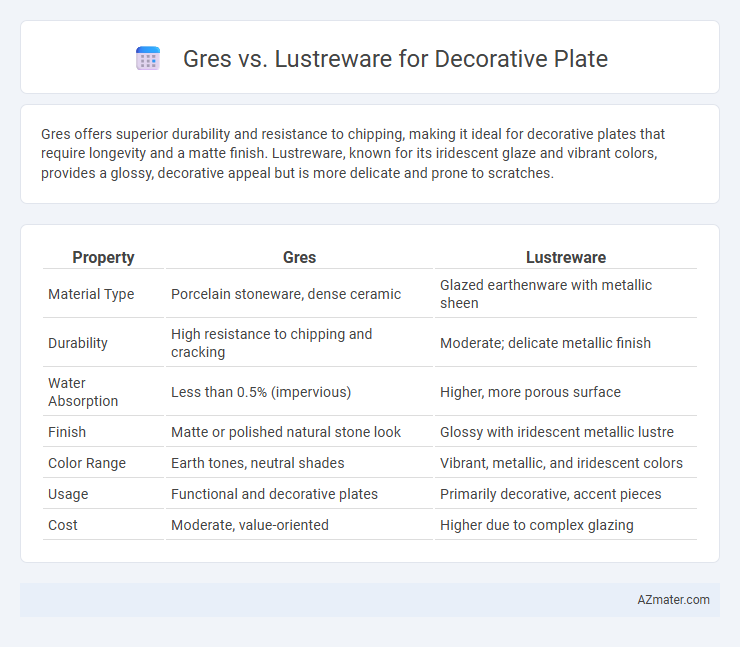Gres offers superior durability and resistance to chipping, making it ideal for decorative plates that require longevity and a matte finish. Lustreware, known for its iridescent glaze and vibrant colors, provides a glossy, decorative appeal but is more delicate and prone to scratches.
Table of Comparison
| Property | Gres | Lustreware |
|---|---|---|
| Material Type | Porcelain stoneware, dense ceramic | Glazed earthenware with metallic sheen |
| Durability | High resistance to chipping and cracking | Moderate; delicate metallic finish |
| Water Absorption | Less than 0.5% (impervious) | Higher, more porous surface |
| Finish | Matte or polished natural stone look | Glossy with iridescent metallic lustre |
| Color Range | Earth tones, neutral shades | Vibrant, metallic, and iridescent colors |
| Usage | Functional and decorative plates | Primarily decorative, accent pieces |
| Cost | Moderate, value-oriented | Higher due to complex glazing |
Introduction to Decorative Plates: Gres and Lustreware
Decorative plates crafted from Gres feature a durable, dense stoneware clay fired at high temperatures, resulting in a sturdy, matte finish ideal for both functional and ornamental use. Lustreware, on the other hand, is known for its distinctive iridescent glaze achieved through metallic oxide applications, offering a vibrant, reflective surface often prized in collectible and decorative ceramics. Both Gres and Lustreware plates highlight unique artistic techniques that enhance their aesthetic appeal and historical significance in decorative arts.
Material Composition: Gres vs Lustreware
Gres decorative plates are made from high-fired stoneware clay that offers durability, a dense texture, and resistance to chipping. Lustreware plates feature a ceramic base coated with a metallic glaze, producing an iridescent sheen through a complex firing process that bonds thin metal layers to the surface. The key difference lies in Gres's robust stoneware material composition versus Lustreware's specialized metallic glazing, affecting both appearance and functional longevity.
Historical Background and Origins
Gres pottery, originating from 19th-century France, is known for its high-fired stoneware durability and matte finish, making it a popular choice for decorative plates that emphasize rustic charm and European craftsmanship. Lustreware, with roots tracing back to Islamic pottery around the 9th century and later perfected during the Italian Renaissance, features a distinctive metallic sheen achieved through a specialized glazing technique that reflects opulence and artistic sophistication. Both Gres and Lustreware showcase historical significance through their unique production methods and cultural influences in decorative plate artistry.
Production Techniques and Craftsmanship
Gres decorative plates are crafted using dense stoneware clay fired at high temperatures, resulting in durable, chip-resistant surfaces with a textured, earthy appeal. Lustreware plates feature a metallic glaze created through a complex firing process involving the application of metal oxides, producing iridescent, reflective finishes prized for their intricate, luminous quality. Both techniques demand skilled artisanship, with Gres emphasizing structural integrity and Lustreware showcasing delicate, surface-level artistry.
Unique Design Features and Aesthetic Appeal
Gres decorative plates showcase a robust matte finish with natural earth tones, emphasizing subtle textures and handcrafted artistry that appeals to rustic and minimalist decor enthusiasts. Lustreware plates feature a distinctive iridescent glaze, producing a shimmering, reflective surface that enhances vibrant color palettes and intricate patterns, ideal for statement or vintage-inspired displays. The choice between Gres and Lustreware hinges on desired aesthetic impact: understated elegance with organic charm versus bold, luminous visual drama.
Durability and Functionality Comparison
Gres plates offer superior durability due to their high-density clay composition, making them resistant to chipping and thermal shock, ideal for everyday use. Lustreware, characterized by its delicate metallic glaze, prioritizes aesthetic appeal but is more prone to scratching and fading with frequent handling. For functional purposes, gres provides greater practicality and longevity, while lustreware is best suited for decorative displays rather than regular dining.
Color Variations and Glazing Effects
Gres plates feature muted earth tones and matte finishes, highlighting natural stoneware textures ideal for rustic decor. Lustreware offers vibrant, iridescent colors with a reflective metallic glaze that creates dynamic light play and depth on decorative plates. The glazing effects in Lustreware produce a glossy, shimmering surface, contrasting with the matte or satin finishes typical in Gres pieces.
Maintenance and Cleaning Guidelines
Gres decorative plates, made from dense, stoneware clay, demand gentle cleaning with mild detergent and soft sponges to prevent surface abrasion and preserve their matte finish. Lustreware plates require delicate handling due to their metallic glaze; avoid harsh chemicals and abrasive pads, using lukewarm water and a soft cloth to maintain their iridescent sheen. Both materials benefit from drying thoroughly to prevent moisture damage, but Lustreware is especially sensitive to prolonged exposure to water and harsh scrubbing.
Popular Uses and Display Options
Gres decorative plates are popular for their durability and matte finish, often used in rustic or contemporary home decor, ideal for wall mounts and open shelving displays. Lustreware plates, featuring a shiny, iridescent glaze, are favored in elegant and vintage-inspired settings, commonly showcased in glass cabinets or as centerpiece accents on dining tables. Both types offer versatile display options suited to highlight their unique textures and craftsmanship in various interior styles.
Choosing the Right Decorative Plate: Gres or Lustreware
Gres offers durability and a matte finish ideal for rustic or modern decor, while Lustreware provides a glossy, iridescent surface that enhances intricate designs with vibrant, reflective qualities. Choosing between Gres and Lustreware depends on the desired aesthetic and use-case; Gres is suited for everyday display and subtle elegance, whereas Lustreware excels in adding a luxurious, eye-catching element to decorative collections. Consider factors such as maintenance, style cohesion, and lighting effects when selecting the right decorative plate material.

Infographic: Gres vs Lustreware for Decorative Plate
 azmater.com
azmater.com